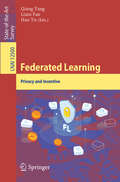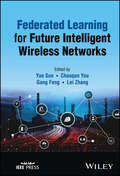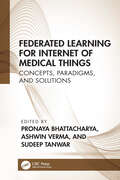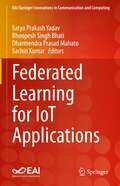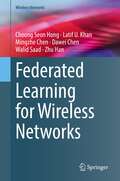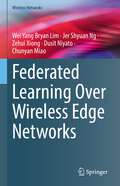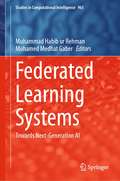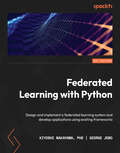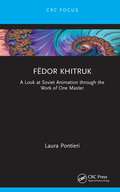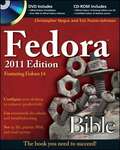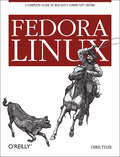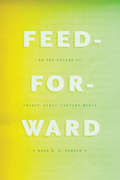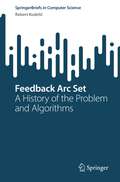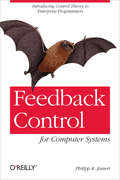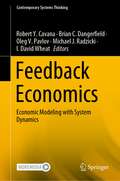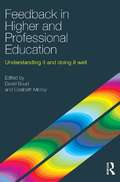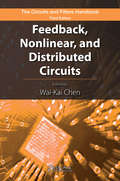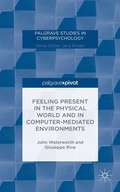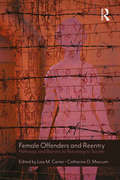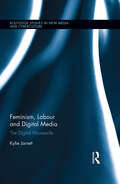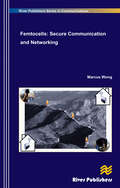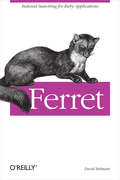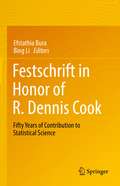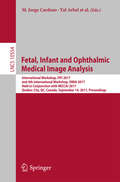- Table View
- List View
Federated Learning: Privacy and Incentive (Lecture Notes in Computer Science #12500)
by Qiang Yang Lixin Fan Han YuThis book provides a comprehensive and self-contained introduction to federated learning, ranging from the basic knowledge and theories to various key applications. Privacy and incentive issues are the focus of this book. It is timely as federated learning is becoming popular after the release of the General Data Protection Regulation (GDPR). Since federated learning aims to enable a machine model to be collaboratively trained without each party exposing private data to others. This setting adheres to regulatory requirements of data privacy protection such as GDPR. This book contains three main parts. Firstly, it introduces different privacy-preserving methods for protecting a federated learning model against different types of attacks such as data leakage and/or data poisoning. Secondly, the book presents incentive mechanisms which aim to encourage individuals to participate in the federated learning ecosystems. Last but not least, this book also describes how federated learning can be applied in industry and business to address data silo and privacy-preserving problems. The book is intended for readers from both the academia and the industry, who would like to learn about federated learning, practice its implementation, and apply it in their own business. Readers are expected to have some basic understanding of linear algebra, calculus, and neural network. Additionally, domain knowledge in FinTech and marketing would be helpful.”
Federated Learning for Future Intelligent Wireless Networks
by Yao Sun Chaoqun You Gang Feng Lei ZhangFederated Learning for Future Intelligent Wireless Networks Explore the concepts, algorithms, and applications underlying federated learning In Federated Learning for Future Intelligent Wireless Networks, a team of distinguished researchers deliver a robust and insightful collection of resources covering the foundational concepts and algorithms powering federated learning, as well as explanations of how they can be used in wireless communication systems. The editors have included works that examine how communication resource provision affects federated learning performance, accuracy, convergence, scalability, and security and privacy. Readers will explore a wide range of topics that show how federated learning algorithms, concepts, and design and optimization issues apply to wireless communications. Readers will also find: A thorough introduction to the fundamental concepts and algorithms of federated learning, including horizontal, vertical, and hybrid FL Comprehensive explorations of wireless communication network design and optimization for federated learning Practical discussions of novel federated learning algorithms and frameworks for future wireless networks Expansive case studies in edge intelligence, autonomous driving, IoT, MEC, blockchain, and content caching and distribution Perfect for electrical and computer science engineers, researchers, professors, and postgraduate students with an interest in machine learning, Federated Learning for Future Intelligent Wireless Networks will also benefit regulators and institutional actors responsible for overseeing and making policy in the area of artificial intelligence.
Federated Learning for Internet of Medical Things: Concepts, Paradigms, and Solutions
by Pronaya Bhattacharya Ashwin Verma Sudeep TanwarThis book intends to present emerging Federated Learning (FL)-based architectures, frameworks, and models in Internet of Medical Things (IoMT) applications. It intends to build on the basics of the healthcare industry, the current data sharing requirements, and security and privacy issues in medical data sharing. Once IoMT is presented, the book shifts towards the proposal of privacy-preservation in IoMT, and explains how FL presents a viable solution to these challenges. The claims are supported through lucid illustrations, tables, and examples that present effective and secured FL schemes, simulations, and practical discussion on use-case scenarios in a simple manner. The book intends to create opportunities for healthcare communities to build effective FL solutions around the presented themes, and to support work in related areas that will benefit from reading the book. It also intends to present breakthroughs and foster innovation in FL-based research, specifically in the IoMT domain. The emphasis of this book is on understanding the contributions of IoMT to healthcare analytics, and its aim is to provide insights including evolution, research directions, challenges, and the way to empower healthcare services through federated learning. The book also intends to cover the ethical and social issues around the recent advancements in the field of decentralized Artificial Intelligence. The book is mainly intended for undergraduates, post-graduates, researchers, and healthcare professionals who wish to learn FL-based solutions right from scratch, and build practical FL solutions in different IoMT verticals.
Federated Learning for IoT Applications (EAI/Springer Innovations in Communication and Computing)
by Sachin Kumar Satya Prakash Yadav Dharmendra Prasad Mahato Bhoopesh Singh BhatiThis book presents how federated learning helps to understand and learn from user activity in Internet of Things (IoT) applications while protecting user privacy. The authors first show how federated learning provides a unique way to build personalized models using data without intruding on users’ privacy. The authors then provide a comprehensive survey of state-of-the-art research on federated learning, giving the reader a general overview of the field. The book also investigates how a personalized federated learning framework is needed in cloud-edge architecture as well as in wireless-edge architecture for intelligent IoT applications. To cope with the heterogeneity issues in IoT environments, the book investigates emerging personalized federated learning methods that are able to mitigate the negative effects caused by heterogeneities in different aspects. The book provides case studies of IoT based human activity recognition to demonstrate the effectiveness of personalized federated learning for intelligent IoT applications, as well as multiple controller design and system analysis tools including model predictive control, linear matrix inequalities, optimal control, etc. This unique and complete co-design framework will benefit researchers, graduate students and engineers in the fields of control theory and engineering.
Federated Learning for Wireless Networks (Wireless Networks)
by Choong Seon Hong Latif U. Khan Mingzhe Chen Dawei Chen Walid Saad Zhu HanRecently machine learning schemes have attained significant attention as key enablers for next-generation wireless systems. Currently, wireless systems are mostly using machine learning schemes that are based on centralizing the training and inference processes by migrating the end-devices data to a third party centralized location. However, these schemes lead to end-devices privacy leakage. To address these issues, one can use a distributed machine learning at network edge. In this context, federated learning (FL) is one of most important distributed learning algorithm, allowing devices to train a shared machine learning model while keeping data locally. However, applying FL in wireless networks and optimizing the performance involves a range of research topics. For example, in FL, training machine learning models require communication between wireless devices and edge servers via wireless links. Therefore, wireless impairments such as uncertainties among wireless channel states, interference, and noise significantly affect the performance of FL. On the other hand, federated-reinforcement learning leverages distributed computation power and data to solve complex optimization problems that arise in various use cases, such as interference alignment, resource management, clustering, and network control. Traditionally, FL makes the assumption that edge devices will unconditionally participate in the tasks when invited, which is not practical in reality due to the cost of model training. As such, building incentive mechanisms is indispensable for FL networks. This book provides a comprehensive overview of FL for wireless networks. It is divided into three main parts: The first part briefly discusses the fundamentals of FL for wireless networks, while the second part comprehensively examines the design and analysis of wireless FL, covering resource optimization, incentive mechanism, security and privacy. It also presents several solutions based on optimization theory, graph theory, and game theory to optimize the performance of federated learning in wireless networks. Lastly, the third part describes several applications of FL in wireless networks.
Federated Learning Over Wireless Edge Networks (Wireless Networks)
by Wei Yang Lim Jer Shyuan Ng Zehui Xiong Dusit Niyato Chunyan MiaoThis book first presents a tutorial on Federated Learning (FL) and its role in enabling Edge Intelligence over wireless edge networks. This provides readers with a concise introduction to the challenges and state-of-the-art approaches towards implementing FL over the wireless edge network. Then, in consideration of resource heterogeneity at the network edge, the authors provide multifaceted solutions at the intersection of network economics, game theory, and machine learning towards improving the efficiency of resource allocation for FL over the wireless edge networks. A clear understanding of such issues and the presented theoretical studies will serve to guide practitioners and researchers in implementing resource-efficient FL systems and solving the open issues in FL respectively.
Federated Learning Systems: Towards Next-Generation AI (Studies in Computational Intelligence #965)
by Muhammad Habib ur Rehman Mohamed Medhat GaberThis book covers the research area from multiple viewpoints including bibliometric analysis, reviews, empirical analysis, platforms, and future applications. The centralized training of deep learning and machine learning models not only incurs a high communication cost of data transfer into the cloud systems but also raises the privacy protection concerns of data providers. This book aims at targeting researchers and practitioners to delve deep into core issues in federated learning research to transform next-generation artificial intelligence applications. Federated learning enables the distribution of the learning models across the devices and systems which perform initial training and report the updated model attributes to the centralized cloud servers for secure and privacy-preserving attribute aggregation and global model development. Federated learning benefits in terms of privacy, communication efficiency, data security, and contributors’ control of their critical data.
Federated Learning with Python: Design and implement a federated learning system and develop applications using existing frameworks
by Kiyoshi Nakayama PhD George JenoLearn the essential skills for building an authentic federated learning system with Python and take your machine learning applications to the next levelKey FeaturesDesign distributed systems that can be applied to real-world federated learning applications at scaleDiscover multiple aggregation schemes applicable to various ML settings and applicationsDevelop a federated learning system that can be tested in distributed machine learning settingsBook DescriptionFederated learning (FL) is a paradigm-shifting technology in AI that enables and accelerates machine learning (ML), allowing you to work on private data. It has become a must-have solution for most enterprise industries, making it a critical part of your learning journey. This book helps you get to grips with the building blocks of FL and how the systems work and interact with each other using solid coding examples.FL is more than just aggregating collected ML models and bringing them back to the distributed agents. This book teaches you about all the essential basics of FL and shows you how to design distributed systems and learning mechanisms carefully so as to synchronize the dispersed learning processes and synthesize the locally trained ML models in a consistent manner. This way, you'll be able to create a sustainable and resilient FL system that can constantly function in real-world operations. This book goes further than simply outlining FL's conceptual framework or theory, as is the case with the majority of research-related literature.By the end of this book, you'll have an in-depth understanding of the FL system design and implementation basics and be able to create an FL system and applications that can be deployed to various local and cloud environments.What you will learnDiscover the challenges related to centralized big data ML that we currently face along with their solutionsUnderstand the theoretical and conceptual basics of FLAcquire design and architecting skills to build an FL systemExplore the actual implementation of FL servers and clientsFind out how to integrate FL into your own ML applicationUnderstand various aggregation mechanisms for diverse ML scenariosDiscover popular use cases and future trends in FLWho this book is forThis book is for machine learning engineers, data scientists, and artificial intelligence (AI) enthusiasts who want to learn about creating machine learning applications empowered by federated learning. You'll need basic knowledge of Python programming and machine learning concepts to get started with this book.
Fëdor Khitruk: A Look at Soviet Animation through the Work of One Master
by Laura PontieriThis book is a first and long-awaited study of the directorial work of the animation master Fëdor Khitruk (1917–2012), an artist who formed in the tradition of classical cel animation only to break the conventions once he turned into a director; a liaison between artists and authorities; a personality who promoted daring films to be created in the Soviet Union dominated by socialist realism; and a teacher and supporter of young artists that continued to carry on his legacy long after the Soviet empire collapsed. Fëdor Khitruk: A Look at Soviet Animation through the Work of One Master reveals Khitruk’s mastery in the art of the moving image and his critical role as a director of films that changed the look of Soviet animation and its relation to the animation world within and beyond the Eastern Bloc. Based on archival research, personal interviews, published memoirs, and perceptive analyses of Khitruk’s production of films for children and adults, this study is a must-read for scholars in Soviet art and culture as well as readers fascinated by traditional animation art.
Fedora Bible 2011 Edition
by Eric Foster-Johnson Christopher NegusGet all the essentials of the major changes in Fedora 14Veteran authors Christopher Negus and Eric Foster-Johnson provide you with a thorough look at the skills needed to master the latest version of Fedora and Red Hat Linux. Their step-by-step instructions walk you through a painless and simple installation of Linux; then you'll explore the major changes to the release of Fedora 14 while also revisiting the previous version so you can see what features have been updated and revised.Focuses on the essentials of the updated and new elements of Fedora Linux 14Addresses using packagekit, running Windows apps, scanning images, and installing over the InternetTouches on how to work in a Linux office with MSFT office compatible office appsCovers new material on zarafa, xenner, deja dup, and moreFeatures a DVD that includes the latest distribution of Fedora Linux as well as a bootable Fedora LiveCDFedora 14 includes many important updates and additions -- this book gets you up to date on the most essential changes.
Fedora Linux: A Complete Guide to Red Hat's Community Distribution
by Chris Tyler"Neither a "Starting Linux" book nor a dry reference manual, this book has a lot to offer to those coming to Fedora from other operating systems or distros." -- Behdad Esfahbod, Fedora developerThis book will get you up to speed quickly on Fedora Linux, a securely-designed Linux distribution that includes a massive selection of free software packages. Fedora is hardened out-of-the-box, it's easy to install, and extensively customizable - and this book shows you how to make Fedora work for you. Fedora Linux: A Complete Guide to Red Hat's Community Distribution will take you deep into essential Fedora tasks and activities by presenting them in easy-to-learn modules. From installation and configuration through advanced topics such as administration, security, and virtualization, this book captures the important details of how Fedora Core works--without the fluff that bogs down other books and help/how-to web sites. Instead, you can learn from a concise task-based approach to using Fedora as both a desktop and server operating system. In this book, you'll learn how to:Install Fedora and perform basic administrative tasks Configure the KDE and GNOME desktops Get power management working on your notebook computer and hop on a wired or wireless network Find, install, and update any of the thousands of packages available for Fedora Perform backups, increase reliability with RAID, and manage your disks with logical volumes Set up a server with file sharing, DNS, DHCP, email, a Web server, and more Work with Fedora's security features including SELinux, PAM, and Access Control Lists (ACLs)Whether you are running the stable version of Fedora Core or bleeding-edge Rawhide releases, this book has something for every level of user. The modular, lab-based approach not only shows you how things work-but also explains why--and provides you with the answers you need to get up and running with Fedora Linux. Chris Tyler is a computer consultant and a professor of computer studies at Seneca College in Toronto, Canada where he teaches courses on Linux and X Window System Administration. He has worked on systems ranging from embedded data converters to Multics mainframes.
Feed-Forward: On the Future of Twenty-First-Century Media
by Mark B. N. HansenEven as media in myriad forms increasingly saturate our lives, we nonetheless tend to describe our relationship to it in terms from the twentieth century: we are consumers of media, choosing to engage with it. In Feed-Forward, Mark B. N. Hansen shows just how outmoded that way of thinking is: media is no longer separate from us but has become an inescapable part of our very experience of the world. Drawing on the speculative empiricism of philosopher Alfred North Whitehead, Hansen reveals how new media call into play elements of sensibility that greatly affect human selfhood without in any way belonging to the human. From social media to data-mining to new sensor technologies, media in the twenty-first century work largely outside the realm of perceptual consciousness, yet at the same time inflect our every sensation. Understanding that paradox, Hansen shows, offers us a chance to put forward a radically new vision of human becoming, one that enables us to reground the human in a non-anthropocentric view of the world and our experience in it.
Feedback Arc Set: A History of the Problem and Algorithms (SpringerBriefs in Computer Science)
by Robert KudelićThe main aim of the book is to give a review of all relevant information regarding a well-known and important problem of Feedback Arc Set (FAS). This review naturally also includes a history of the problem, as well as specific algorithms. To this point such a work does not exist: There are sources where one can find incomplete and perhaps untrustworthy information. With this book, information about FAS can be found easily in one place: formulation, description, theoretical background, applications, algorithms etc. Such a compendium will be of help to people involved in research, but also to people that want to quickly acquaint themselves with the problem and need reliable information. Thus research, professional work and learning can proceed in a more streamlined and faster way.
Feedback Control for Computer Systems
by Philipp K. JanertHow can you take advantage of feedback control for enterprise programming? With this book, author Philipp K. Janert demonstrates how the same principles that govern cruise control in your car also apply to data center management and other enterprise systems. Through case studies and hands-on simulations, you'll learn methods to solve several control issues, including mechanisms to spin up more servers automatically when web traffic spikes. Feedback is ideal for controlling large, complex systems, but its use in software engineering raises unique issues. This book provides basic theory and lots of practical advice for programmers with no previous background in feedback control. Learn feedback concepts and controller design Get practical techniques for implementing and tuning controllers Use feedback "design patterns" for common control scenarios Maintain a cache's "hit rate" by automatically adjusting its size Respond to web traffic by scaling server instances automatically Explore ways to use feedback principles with queueing systems Learn how to control memory consumption in a game engine Take a deep dive into feedback control theory
Feedback Economics: Economic Modeling with System Dynamics (Contemporary Systems Thinking)
by Robert Y. Cavana Brian C. Dangerfield Oleg V. Pavlov Michael J. Radzicki I. David WheatThis book approaches economic problems from a systems thinking and feedback perspective. By introducing system dynamics methods (including qualitative and quantitative techniques) and computer simulation models, the respective contributions apply feedback analysis and dynamic simulation modeling to important local, national, and global economics issues and concerns. Topics covered include: an introduction to macro modeling using a system dynamics framework; a system dynamics translation of the Phillips machine; a re-examination of classical economic theories from a feedback perspective; analyses of important social, ecological, and resource issues; the development of a biophysical economics module for global modelling; contributions to monetary and financial economics; analyses of macroeconomic growth, income distribution and alternative theories of well-being; and a re-examination of scenario macro modeling.The contributions also examine the philosophical differences between the economics and system dynamics communities in an effort to bridge existing gaps and compare methods. Many models and other supporting information are provided as online supplementary files. Consequently, the book appeals to students and scholars in economics, as well as to practitioners and policy analysts interested in using systems thinking and system dynamics modeling to understand and improve economic systems around the world."Clearly, there is much space for more collaboration between the advocates of post-Keynesian economics and system dynamics! More generally, I would like to recommend this book to all scholars and practitioners interested in exploring the interface and synergies between economics, system dynamics, and feedback thinking." Comments in the Foreword by Marc Lavoie, Emeritus Professor, University of Ottawa and University of Sorbonne Paris Nord
Feedback in Higher and Professional Education: Understanding it and doing it well
by David Boud Elizabeth MolloyLearners complain that they do not get enough feedback, and educators resent that although they put considerable time into generating feedback, students take little notice of it. Both parties agree that it is very important. Feedback in Higher and Professional Education explores what needs to be done to make feedback more effective. It examines the problem of feedback and suggests that there is a lack of clarity and shared meaning about what it is and what constitutes doing it well. It argues that new ways of thinking about feedback are needed. There has been considerable development in research on feedback in recent years, but surprisingly little awareness of what needs to be done to improve it and good ideas are not translated into action. The book provides a multi-disciplinary and international account of the role of feedback in higher and professional education. It challenges three conventional assumptions about feedback in learning: That feedback constitutes one-way flow of information from a knowledgeable person to a less knowledgeable person. That the job of feedback is complete with the imparting of performance-related information. That a generic model of best-practice feedback can be applied to all learners and all learning situations It seeking a new approach to feedback, it proposes that it is necessary to recognise that learners need to be much more actively involved in seeking, generating and using feedback. Rather than it being something they are subjected to, it must be an activity that they drive.
Feedback, Nonlinear, and Distributed Circuits (The Circuits and Filters Handbook, 3rd Edition)
by Wai-Kai ChenUpon its initial publication, the Handbook of Circuits and Filters broke new ground. It quickly became the resource for comprehensive coverage of issues and practical information that can be put to immediate use. Not content to rest on his laurels, editor Wai-kai Chen divided the second edition into volumes, making the information easily accessible and digestible. In the third edition, these volumes have been revised, updated, and expanded so that they continue to provide solid coverage of standard practices and enlightened perspectives on new and emerging techniques. Feedback, Nonlinear, and Distributed Circuits draws together international contributors who discuss feedback amplifier theory and then move on to explore feedback amplifier configurations. They develop Bode’s feedback theory as an example of general feedback theory. The coverage then moves on to the importance of complementing numerical analysis with qualitative analysis to get a global picture of a circuit’s performance. After reviewing a wide range of approximation techniques and circuit design styles for discreet and monolithic circuits, the book presents a comprehensive description of the use of piecewise-linear methods in modeling, analysis, and structural properties of nonlinear circuits highlighting the advantages. It describes the circuit modeling in the frequency domain of uniform MTL based on the Telegrapher’s equations and covers frequency and time domain experimental characterization techniques for uniform and nonuniform multiconductor structures. This volume will undoubtedly take its place as the engineer's first choice in looking for solutions to problems encountered in the analysis and behavior predictions of circuits and filters.
The Feel of Algorithms
by Minna RuckensteinWhy do we feel excited, afraid, and frustrated by algorithms?The Feel of Algorithms brings relatable first-person accounts of what it means to experience algorithms emotionally alongside interdisciplinary social science research, to reveal how political and economic processes are felt in the everyday. People’s algorithm stories might fail to separate fact and misconception, and circulate wishful, erroneous, or fearful views of digital technologies. Yet rather than treating algorithmic folklore as evidence of ignorance, this novel book explains why personal anecdotes are an important source of algorithmic knowledge. Minna Ruckenstein argues that we get to know algorithms by feeling their actions and telling stories about them. The Feel of Algorithms shows how taking everyday algorithmic emotions seriously balances the current discussion, which has a tendency to draw conclusions based on celebratory or oppositional responses to imagined future effects. An everyday focus zooms into experiences of pleasure, fear, and irritation, highlighting how political aims and ethical tensions play out in visions, practices, and emotional responses. This book shows that feelings aid in recognizing troubling practices, and also calls for alternatives that are currently ignored or suppressed.
Feeling Present in the Physical World and in Computer-Mediated Environments
by John Waterworth Giuseppe RivaThis concise volume presents for the first time a coherent and detailed account of why we experience feelings of being present in the physical world and in computer-mediated environments, why we often don't, and why it matters - for design, psychotherapy, tool use and social creativity amongst other practical applications.
Female Offenders and Reentry: Pathways and Barriers to Returning to Society
by Lisa M. Carter Catherine D. MarcumOften, research concerning the female offender is scarce. This book adds to the criminological literature on the topic of reentry for women, focusing on the barriers women face as they return to society and adjust to life after incarceration. Each chapter addresses specific issues, challenges, and obstacles affiliated with the hindrance of successful reentry processes associated with female offenders, as well as data-driven empirical studies. While corrections has often misunderstood or overlooked the needs of returning offenders, the shortcomings of the institutions have a greater impact on women than on their male counterparts, particularly regarding the occurrence of social and medical problems, especially those related to mental health and substance abuse. Female Offenders and Reentry helps criminal justice students and practitioners see the full picture when considering the challenges faced by female offenders reintegrating into society.
Feminism, Labour and Digital Media: The Digital Housewife (Routledge Studies in New Media and Cyberculture)
by Kylie JarrettThere is a contradiction at the heart of digital media. We use commercial platforms to express our identity, to build community and to engage politically. At the same time, our status updates, tweets, videos, photographs and music files are free content for these sites. We are also generating an almost endless supply of user data that can be mined, re-purposed and sold to advertisers. As users of the commercial web, we are socially and creatively engaged, but also labourers, exploited by the companies that provide our communication platforms. How do we reconcile these contradictions? Feminism, Labour and Digital Media argues for using the work of Marxist feminist theorists about the role of domestic work in capitalism to explore these competing dynamics of consumer labour. It uses the concept of the Digital Housewife to outline the relationship between the work we do online and the unpaid sphere of social reproduction. It demonstrates how feminist perspectives expand our critique of consumer labour in digital media. In doing so, the Digital Housewife returns feminist inquiry from the margins and places it at the heart of critical digital media analysis.
Femtocells: Secure Communication and Networking (River Publishers Series In Communications Ser.)
by Marcus WongWith Femtocell popularities and deployments on the rise, a number of Femtocell security breach has been reported as a result of pre-standards versions of Femtocells that did not conform to published standards or implemented as a result of lack of understanding of basic security principles. A considerable amount of effort has been devoted, both in industry forums and standards developing organizations, towards creating technical specifications for the architecture, operational, and security of the Femtocells. Security remains on the minds of operators as the traditionally closed operator core network opens up with the Femtocells extending into the homes of users and potential hackers with more and more powerful tools. Technical topics discussed in the book include:• UMTS/LTE Femtocell security and threat analysis;• CDMA Femtocell security;• WiMAX Femtocell security;• LIPA and SIPTO security;• Small Cells;Femtocells: Secure Communication and Networking provides an in-depth analysis and research results on the security design of Femtocells based on UMTS, LTE, CDMA and WiMAX access technologies. Threat analysis, security requirements as well as security mechanisms used to counter the threats and potential attacks are provided in details covering every aspect of Femtocell security. Femtocells: Secure Communication and Networking is ideal for personnel in communication, networking and security industries as well as academic staff and master/research students in network security, computer science, operational research, electrical engineering and telecommunication systems and the Internet.
Ferret
by David BalmainWith the introduction of Ferret, Ruby users now have one of the fastest and most flexible search libraries available. And it's surprisingly easy to use. This book will show you how to quickly get up and running with Ferret. You'll learn how to index different document types such as PDF, Microsoft Word, and HTML, as well as how to deal with foreign languages and different character encodings. Ferret describes the Ferret Query Language in detail along with the object-oriented approach to building queries. You will also be introduced to sorting, filtering, and highlighting your search results, with an explanation of exactly how you need to set up your index to perform these tasks. You will also learn how to optimize a Ferret index for lightning fast indexing and split-second query results.
Festschrift in Honor of R. Dennis Cook: Fifty Years of Contribution to Statistical Science
by Efstathia Bura Bing LiIn honor of professor and renowned statistician R. Dennis Cook, this festschrift explores his influential contributions to an array of statistical disciplines ranging from experimental design and population genetics, to statistical diagnostics and all areas of regression-related inference and analysis. Since the early 1990s, Prof. Cook has led the development of dimension reduction methodology in three distinct but related regression contexts: envelopes, sufficient dimension reduction (SDR), and regression graphics. In particular, he has made fundamental and pioneering contributions to SDR, inventing or co-inventing many popular dimension reduction methods, such as sliced average variance estimation, the minimum discrepancy approach, model-free variable selection, and sufficient dimension reduction subspaces.A prolific researcher and mentor, Prof. Cook is known for his ability to identify research problems in statistics that are both challenging and important, as well as his deep appreciation for the applied side of statistics. This collection of Prof. Cook's collaborators, colleagues, friends, and former students reflects the broad array of his contributions to the research and instructional arenas of statistics.
Fetal, Infant and Ophthalmic Medical Image Analysis: International Workshop, FIFI 2017, and 4th International Workshop, OMIA 2017, Held in Conjunction with MICCAI 2017, Québec City, QC, Canada, September 14, Proceedings (Lecture Notes in Computer Science #10554)
by M. Jorge Cardoso, Tal Arbel, Andrew Melbourne, Hrvoje Bogunovic, Pim Moeskops, Xinjian Chen, Ernst Schwartz, Mona Garvin, Emma Robinson, Emanuele Trucco, Michael Ebner, Yanwu Xu, Antonios Makropoulos, Adrien Desjardin and Tom VercauterenThis book constitutes the refereed joint proceedings of the International Workshop on Fetal and Infant Image Analysis, FIFI 2017, and the 6th International Workshop on Ophthalmic Medical Image Analysis, OMIA 2017, held in conjunction with the 20th International Conference on Medical Imaging and Computer-Assisted Intervention, MICCAI 2017, in Québec City, QC, Canada, in September 2017. The 8 full papers presented at FIFI 2017 and the 20 full papers presented at OMIA 2017 were carefully reviewed and selected. The FIFI papers feature research on advanced image analysis approaches focused on the analysis of growth and development in the fetal, infant and paediatric period. The OMIA papers cover various topics in the field of ophthalmic image analysis.
